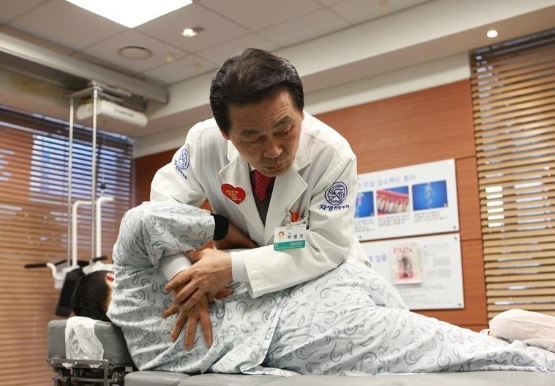National Health Insurance to cover Chuna treatment expense amid controversy
By Park Ju-youngPublished : Jan. 14, 2019 - 17:34
The National Health Insurance will offer partial coverage of the cost of Chuna manual therapy starting March, amid controversies surrounding the treatment’s effectiveness.
Chuna manual therapy is a treatment that corrects spinal disorders by pushing and pulling body parts by hand, similar to Western chiropractic treatment. As the procedure is not paid for by the National Health Insurance, the cost of the procedure varies widely, from 8,100 won ($7.20) to 200,000 won, according to the National Health Insurance Service’s 2018 survey.
Chuna manual therapy is a treatment that corrects spinal disorders by pushing and pulling body parts by hand, similar to Western chiropractic treatment. As the procedure is not paid for by the National Health Insurance, the cost of the procedure varies widely, from 8,100 won ($7.20) to 200,000 won, according to the National Health Insurance Service’s 2018 survey.

Patients can receive Chuna treatment for 10,000 won to 30,000 won with National Health Insurance coverage, according to the Ministry of Health and Welfare and National Health Insurance Service on Monday
In addition, the insurance will cover 50 percent of the cost for complicated Chuna procedures for treating herniated lumbar discs or spinal stenosis, and 20 percent of the cost for other musculoskeletal disorders.
Patients are eligible to receive 20 Chuna procedures per year with the insurance, while doctors are limited to offering the Chuna procedure at reduced cost to 18 patients a day.
The Health Ministry decided to expand the insurance coverage, as recent research showed demand for the treatment.
Since February 2018, the ministry had conducted a pilot project on covering the Chuna treatment with the National Health Insurance at 65 traditional Korean clinics, and 92.8 percent of 416 patients who underwent the procedure more than three times showed positive reactions to the treatment.
Asked why they liked the treatment, 75.1 percent responded that it worked well for them.
The Association of Korean Medicine welcomed the ministry’s decision, saying the expanded insurance coverage is a “reasonable action for improving the public’s health.”
“The number of patients who receive Chuna treatment is increasing every year according to National Health Insurance Service statistics,” the association said in a statement.
“The expanded insurance coverage will alleviate the financial burden for the patients and contribute to improving the public’s health by raising the accessibility of Korean medicine.”
The Korean Medical Association, however, strongly opposed the coverage of the Chuna treatment, saying its efficacy and safety have not been confirmed.
“We normally put tremendous efforts to prove the effectiveness, safety and cost-effectiveness of treatments or medical procedures to have them covered by the health insurance,” a spokesperson of the KMA, Park Jong-hyuk, told The Korea Herald by phone Monday.
Park argued that there is not enough scientific evidence to prove the effectiveness and safety of the Chuna treatment, except some theses that claim that patients are satisfied with the procedure
“If the money for expanded insurance coverage is used for covering the costs of emergency treatment or intensive medical care instead, it could save many patients’ lives.”
According to Park, the KMA will work on raising awareness about the inappropriateness of the coverage of the Chuna treatment in an effort to reverse the ministry’s decision.
By Park Ju-young (jupark@heraldcorp.com)






![[From the Scene] Monks, Buddhists hail return of remains of Buddhas](http://res.heraldm.com/phpwas/restmb_idxmake.php?idx=644&simg=/content/image/2024/04/19/20240419050617_0.jpg&u=20240419175937)








![[From the Scene] Monks, Buddhists hail return of remains of Buddhas](http://res.heraldm.com/phpwas/restmb_idxmake.php?idx=652&simg=/content/image/2024/04/19/20240419050617_0.jpg&u=20240419175937)

![[KH Explains] Hyundai's full hybrid edge to pay off amid slow transition to pure EVs](http://res.heraldm.com/phpwas/restmb_idxmake.php?idx=652&simg=/content/image/2024/04/18/20240418050645_0.jpg&u=20240419100350)

![[Today’s K-pop] Illit drops debut single remix](http://res.heraldm.com/phpwas/restmb_idxmake.php?idx=642&simg=/content/image/2024/04/19/20240419050612_0.jpg&u=)